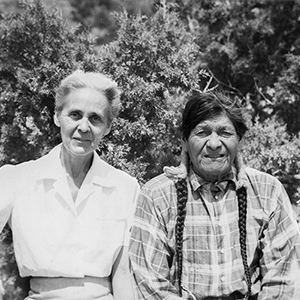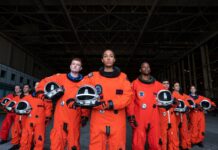By Brian Nixon —
What does a bomb-making scientist have to do with a Quaker-owned teahouse?

The answer: Edith Warner.
With all the fanfare the movie Oppenheimer received, winning multiple Oscar awards, one would think that Oppenheimer’s story is well told. But behind the story of a passionate scientist, turned peacemaker, is another narrative: one of a simple woman and her Native American confidante serving tea to the Manhattan Project scientists.
According to the National Park Service, “Edith Warner and her Pueblo companion, Tilano, set up a tea house and store in a little adobe structure near the Otowi Bridge for passing travelers. Before long, convoys of army vehicles and buses could be seen crossing the bridge on their way to Los Alamos. Oppenheimer eventually arranged for Edith Warner to host dinners for residents living behind the fence in Los Alamos. While trips to Santa Fe required a special day pass, staff and their families did not have to get a day pass to enjoy a meal at the tea house. Shortly after, Edith Warner’s tea house became a popular destination for scientists and their families, enjoying tea and Warner’s famous chocolate cake.”

On a recent visit to both Oppenheimer’s house in Los Alamos, New Mexico and Edith Warner’s teahouse (outside of the city), I was struck by the contrasting idea of a Quaker woman (raised Baptist but switched denominations as an adult) and a bomb-making motley crew of scientists rubbing shoulders. But history is often more fascinating than fiction.
As many know, Quakers are pacifists; the scientists were not (at least at the beginning of the Project).

However, together, they were able to meet over something more endearing—food and friendship.
Quoting Manhattan Project scientist, Dr. Philip Morrison (Peggy Pond Church notes in her book about Edith Warner, The House At Otowi Bridge), “Edith Warner stands in the history of those desperate times as a kind of rainbow…a sign that war and bombs are not all that men and women are capable of building.”
Though Peggy Pond Church doesn’t detail any opposing conversations between Warner and the Manhattan scientists in her book, I think their relationship can act as a template on how to interact with people you may disagree, using the acronym LOVE as a guide.
L: Listen. Listen to opposing points of view and perspectives. And though you may not always agree—and sometime disagree strongly—remember that a person is behind a perspective. And Christians are called to love people, being the perfume of Christ, an aroma of His grace to a watching world. Furthermore, listening leads to learning. As I write in my book Tilt, “Listening is part of learning and learning helps us discover the truth.” By listening and learning, you get a sense of how the person leans, providing an opportunity to love the one you are listening to.
O: Offer. Offer your perspective in respect, keeping in mind that being correct should never override character— joy, peace, forbearance, kindness, goodness, faithfulness, gentleness and self-control. Truth matters, yes, but so does the truth of our actions. Like two sides of a coin—the certainty of reality (Biblical or scientific) and the reality of conduct go together. Put another way, to be right should not overshadowing being righteous, virtuous. Knowing and doing are conjoined.
V: Value. Value the person as a human being, not as a number, but a name, a person made in God’s image. All people are Imago Dei (Latin for “image of God”). When you meet with someone you disagree, try to get beyond what you disagree with (as important as it may be) and yearn to find common values, qualities that bind you as humans. As ethicist Melody Stanford Martin states” Do: Tell people they matter… Don’t: Let frustration overcome you. Chanel it.” For Warner, how she communicated that people matter was through tea, food, and friendship. For you, it may be something else—a hobby or community and church connection.
E: Evaluate. The world is full of information. Some good, some not-so-good. As Christ-followers we are called to evaluate—to assess and discern—that which is profitable to our faith versus that which is problematic to our faith. When meeting with people, one can’t help but to evaluate their life, words, and actions (we all do it; it’s a human quality). Our goal is not to evaluate in a judgmental sense, but with jurisprudence sagacity, weighing what his helpful versus what is harmful. Sagacity is a form of wisdom, intelligent discernment. And remember: Wisdom is not knowing how to make a gun (understanding), but when not to use one.

Across the street from Edith Warner’s home stands the Otowi Suspension Bridge, a registered historical landmark, and used regularly by Warner and the Los Alamos scientists. The bridge is a fitting metaphor for what Christians can—and should—do with people, following the lead of our Bridge, the Mediator, Jesus Christ (I Timothy 2:5). Christians can be a bridge—a physical symbol—between God’s love and broken humanity, providing a pathway over obstacles, a structure to help people cross from opposite sides to connect.
Edith Warner’s story is a fascinating look at two contrasting worldviews, a bridge between simplicity and service on one hand and scientists and struggle (to make a bomb) on the other. How they met in-between these worldviews—over food, friendship, and festivity—reminds me of philosopher Hans-Georg Gadamer’s view of beauty. According to Gadamer, beauty should encompass play, symbolism, and festivity. I’m sure Warner, Oppenheimer, and others did all three at given points in their interactions, and because they did, they were able to love those whom they disagreed, a beautiful bridge in bleak times. Or, as Dr. Morrison, reminds us, people can be a beautiful “rainbow…a sign” that we are capable of more. And sometimes that “more” is a listening ear over a cup of tea, walking across a bridge for fellowship.



